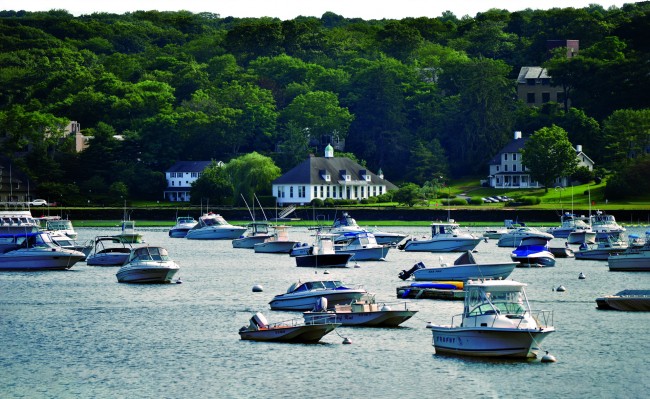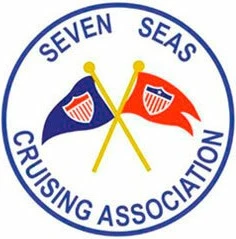(Editor’s Note: This article originally appeared in the premiere issue of Waterway Guide Magazine in 2006. Our point? While populations grow and businesses come and go, not much changes on the water. We have updated and omitted where necessary, but we think you will find the areas below to be mostly as described 16 years ago.)

After many warm Bahamian winters aboard, we decided to spend last summer exploring Long Island Sound board Geneva, our Island Packet 40.

It did not take long to discover why the Sound, with its abundance of destinations, is one of the country’s favored cruising areas. It would take many years of gunkholing to see it all. From Manhasset Bay to Cold Spring Harbor, the many friendly cruisers we met only enhanced the Sound’s beauty.

Manhasset Bay
We first anchored in New York’s Manhasset Bay, just outside the mooring field in front of Brewer Capri Marina East (now Safe Harbor Capri). While the bay has a number of large mooring fields, there is still plenty of room to anchor with excellent holding in 7 to 17 feet of water with very good protection from almost all directions. Most mooring fields here are private, but there is usually room for transients and the yacht clubs generally offer reciprocal courtesies to members of other clubs. We enjoyed our morning coffees with an excellent view of the sunrise, watching yachts of every size and type starting their days.
Port Washington, the largest town on Manhasset Bay, recognizes the value of the boating community. At the town dock we were able to use pump-out facilities, get water and secure our dinghy for visits ashore. As do many towns on Long Island Sound, Port Washington offers mobile pump-out service (hail on VHF Channel 9) for a very nominal fee, a recognition by the various levels of government that the Sound is sensitive and needs protection.
Port Washington’s Main Street provides a snapshot of the idyllic small village lifestyle. Among the beautiful trees and convenient benches you can find boutiques, art galleries, antiques stores, jewelry stores, an excellent library, banks, restaurants of every type and a hardware store. And for those who wish to continue their travel by land, trains run frequently to New York City.
Adjacent to the town dock is the Philip Sousa bandstand. Concerts are a weekly event here, and we enjoyed one from the boat as the music wafted across the bay. Where else could you enjoy the setting sun and a wee glass of local wine, all with the accompaniment of wonderful music?

Oyster Bay Harbor
We left the next morning for a short trip to Oyster Bay Harbor, which offers fine beaches, well-groomed estates, a prosperous oyster fleet and a choice of protected anchorages. Notably, Oyster Bay served during the early 1900s as the summer White House for President Theodore Roosevelt.
As Oyster Bay is a very popular destination and space is at a premium, it is essential to contact Oyster Bay Marine Center well in advance if you wish to have either a slip or mooring ball available. They also provide launch service.
Because of the large weekend boating crowds arriving for the Fourth of July, we anchored in a large, sheltered cove with good holding between the town and the high bluffs of Cove Neck. To our great enjoyment, an extensive marsh at the head of the cove featured an abundance of bird life. Our own early arrival that weekend allowed us to get settled here before the throngs cruised in to watch the spectacular evening fireworks display at Cove Point.
From Oyster Bay Marine Center, a five-minute walk through a park-like setting brings you to the town’s refined blend of commercial services and beautiful residences. This mélange, along with the effort to preserve the better examples of the past, gives Oyster Bay its special charm.
Raynham Hall, in the center of town, is one example of the town’s preservation efforts. Built in 1740, it served as as a British headquarters during the Revolutionary War. Previously it was the home of Robert Townsend, Gen. George Washington’s famous spy. Now a museum, Raynham Hall is open Tuesday through Sunday from 1:00 p.m. to 5:00 p.m. (516-922-6808).
The Theodore Roosevelt summer home is located atop Sagamore Hill at Cove Neck, a 3-mile walk from the village. Built in 1885, it is now preserved as a National Historic Monument. The home, displaying memorabilia from Roosevelt’s legendary life, is open for tours by advance reservation only (877-444-6777). The grounds are open to the public daily, year-round.
Some of the more interesting tour tidbits: While in residence, Roosevelt regularly commuted to New York by train, and it wasn’t until 1901, when he became president, that a telephone was installed. Prior to that, messages were delivered to Sagamore hill by bicycle from the local drugstore. Roosevelt died in his bed at Sagamore Hill–as he had many times predicted he would–at age 60, and his final resting place lies in a small cemetery located on the property.
Providing the perfect ending to our day of sightseeing, our evening was capped by a spectacular 30-minute extravaganza of fireworks over the harbor. Almost as spectacular was the orderly procession of more than 600 boats somehow leaving the scene without serious incident.

Cold Spring Harbor
The following day we took the short trip around the corner to Cold Spring Harbor. The narrowness of the harbor and its steep, wooded bluffs reminded us of a small fjord. Those wishing to anchor will have to do so north of Cold Spring Beach, as the inner harbor is full of mooring balls. Call Powles Marina for information about the availability of a mooring; launch service is provided. We walked about a half mile into the town of Cold Springs Harbor, named by settlers in 1653 for the harbor’s icy freshwater springs.
From 1836 to 1860, this area became one of Long Island’s most active whaling ports, and later, a busy fishing village. Main Street is home to the Whaling Museum, a tribute to Long Island’s maritime history. It is nestled among beautifully kept 18th- and 19th-century homes. Permanent exhibits include a scrimshaw collection, a fully equipped whale boat, ship models, whaling implements, figureheads and a diorama showing Cold Springs Harbor during the whaling days. The museum is open Tuesday through Sunday from 11:00 a.m. to 5:00 p.m. (631-367-3418).
For a walk back in time, stroll along Main Street and enjoy the historic homes, boutiques and antiques shops. When it’s time to leave and you need to reprovision, several grocery stores are a few miles from the marina near the highway and Cold Spring Plaza Delicatessen (15 Harbor Rd.) can satisfy almost every need.











